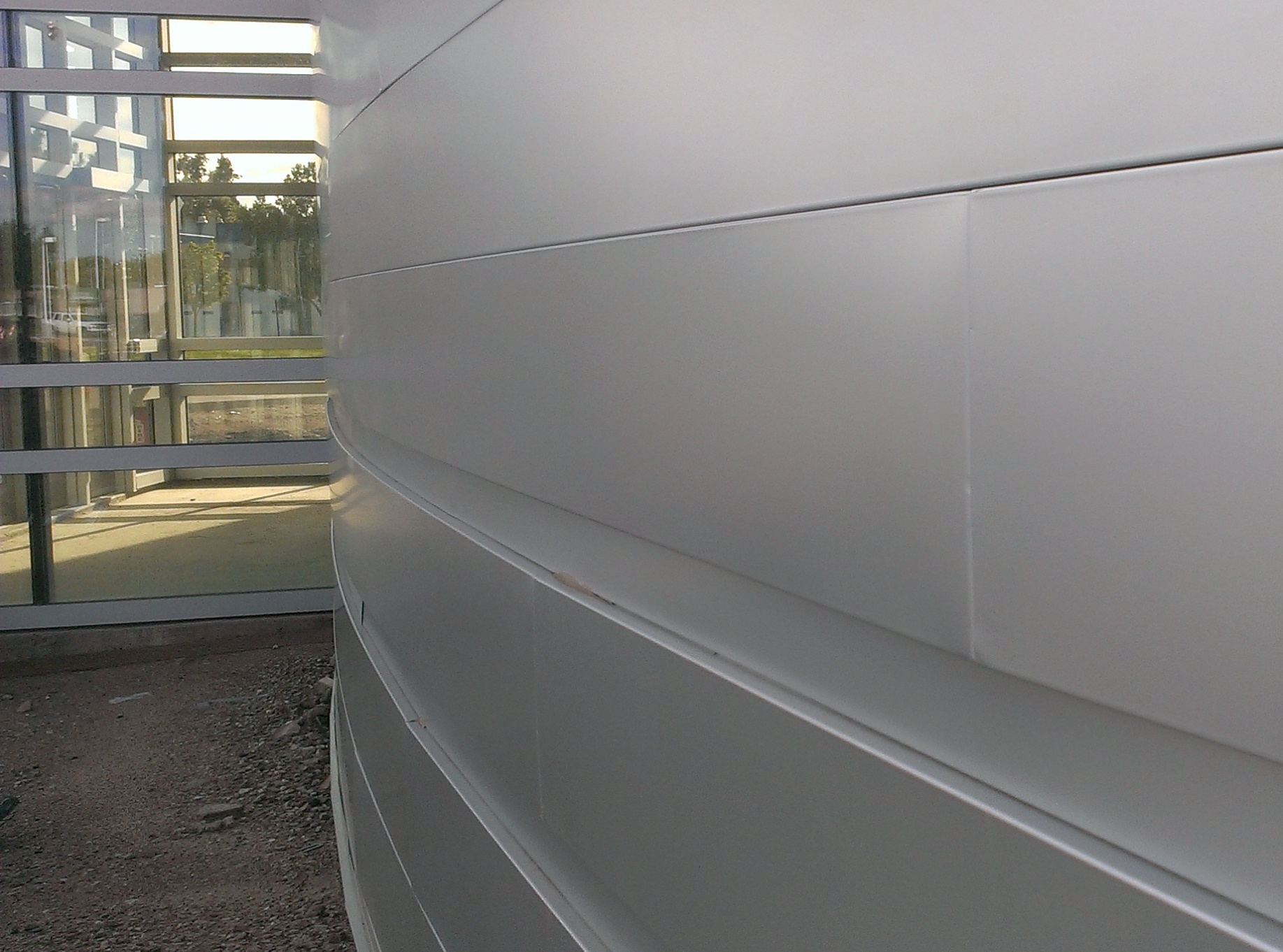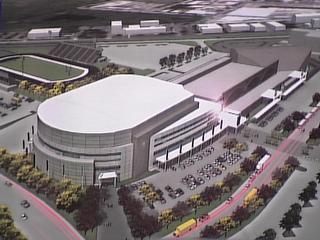 Â
 
Guest post and photos by Citizens for Integrity;
Drive by the shiny New Denny Sanford Premiere Events Center in the classy north side industrial neighborhood. But don’t stay too long. On some hot summer South Dakota day or corresponding super cold winter blast, it might become dangerous as the panels break their tiny screws. The blizzard winds might just catch the reverse flashed or lapped panels and send them flying. Not quite Dakota smart.
When someone looks at the EC from a distance (quite a distance) it has a decent look. The viewer can see what the architect was trying to accomplish. As the viewer gets closer, the look becomes strange. Something is not quite right. If the viewer gets a chance to get real close all kinds of problems arise (or bulge).
I drive past the EC almost every day in my work. Watching the process of snapping this building together like a big puzzle is interesting to me. I know, boring activity to most.
As the EC iron was being placed, the 400′ cranes were fascinating to watch as they danced under the planes taking off and landing on the nearby runway. Then as the contractors rushed to close up areas, the light gauge steel studs went in so interior sheetrock could get started. A fiberglass blanket could be seen going up between the metal studs. What I must have missed was any structural plywood before the polystyrene was applied. I found this surprising but oh well, I’m not involved and there must be a really strong cover going on.
What I didn’t understand from the very first pieces of siding, were the interesting bulges occurring as I saw the workers struggling with the installation. Maybe the possible lack of a strong backing allowed for the fight ahead. The foam insulation board might be there to provide a ‘cushion’ to help force the unbending siding on?
Why does this fascinate me? My family has been in the metalworking business for many decades. I grew up learning basics of how to make metal do things by incredible experts. When creating a sheetmetal enclosure out of any metal intended to be applied to a curved surface, it must be pre-rolled or formed to the shape it is intended to be. It is not possible to ‘field form’ 16 foot pre-formed straight channels. A wrinkling occurs on the horizontal edges and the bulging look to the vertical face. The vertical and horizontal edges must be pre-formed prior to paint being applied.
BTW, why weren’t the insert ends pre-formed with enough tolerance to allow them to fit into their corresponding sleeves? You should see the field worker modifications currently allowing water to flow into the wall cavity.
We might as well discuss the finish. It appears this is a relatively inexpensive cold-rolled galvanized steel they have used. I have purchased thousands of tons of 20 gauge rolled-rolled steel. It is a nice surface to paint but not very weather resistant. Each flat piece of steel actually has a minimum of 6 sides, I know this is hard to believe but there are. Now take the steel and form it into a shape ready to be attached. The forming process creates many more edges to be covered by paint. Each of these edges can only hold a certain amount of paint or virtually none depending on the application process. My calculations show there are likely at least 10 paintable edges with 8 paintable surfaces to each of these panels. A total of 18. Everywhere this metal has be run through a press brake, the coating has been opened or cracked, ready to start a rusting action.
Think of how our South Dakota galvanized grain bins dull and rust with age. Rust always starts on the damp or exposed edges.
Why are 18 surfaces this important? As the building ages, extreme weather is going to make the building panels move. It is already seen on the hot days we have had this summer. I have noticed a ‘popping’ look on the upper eastside as the morning sun beat on it. Nice touch. I wonder what would happen with all the heavy bass of Jason Aldean or Cher type concerts. Instead of swaying Pavilion balconies we can watch already stressed tiny screws blowing their tops.
BTW, have you ever been in a metal building and heard it pop in hot weather or ‘crack’ in bitter cold? You’d swear it was coming in on you. This is the natural expansion and contraction a designer must plan for.
Ok, back to the paint or silver coating. There is no horizontal expansion gap between the panels. Friction is a metal coatings worst friend. The panels will shrink and expand at differing rates. As constructed, this will wear the coating off and create a place for rust to begin. The building will begin to turn a dirty looking color in some interesting spots. Have you ever changed a baby’s diaper? We called the color this building will become “Baby Poo†brown. It will not be pleasant and with all the reverse flashing installed allowing water to enter the building walls, the building will begin to stink of smelly mold.
There is only one way to fix this building siding. The exterior siding must be completely removed. To retain the silver look, cover it with a preformed proper aluminized or stainless material. All the flashings must also be replaced. This building is a disaster and it is not even open. Who is going to pay? Or are we going to rely on those poor little self-tapping steel metal screws to work for 50 years?
I now know how we can have a quick $200 million events center for $100 million. Nice job Mr. Mayor! Is this how Mortenson is going to build us an indoor swimming pool?




